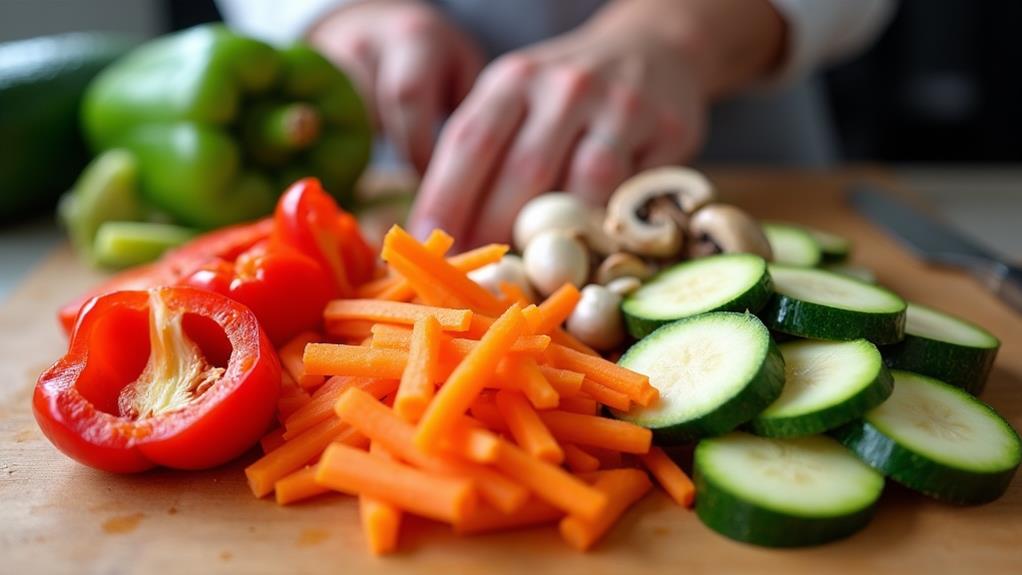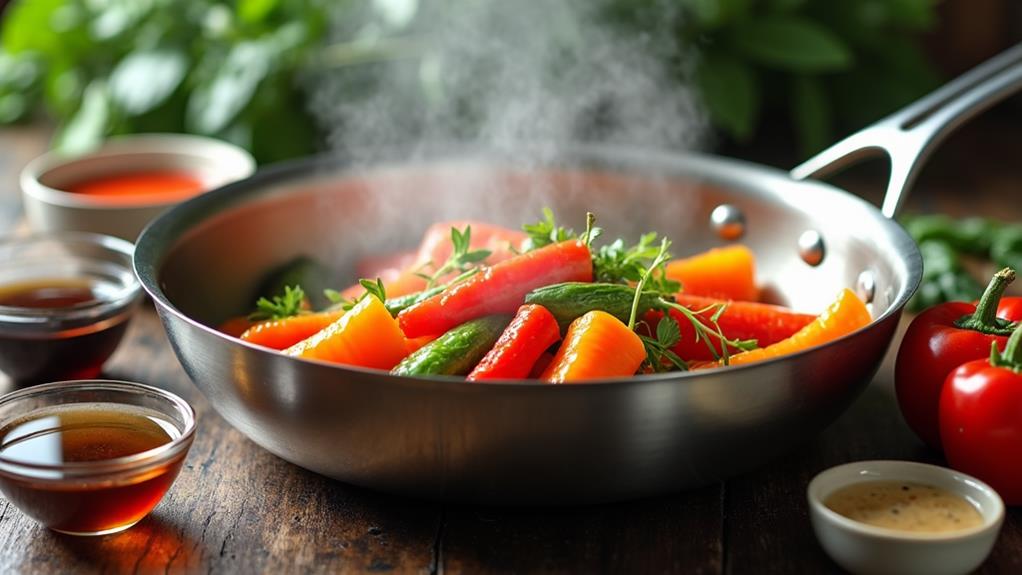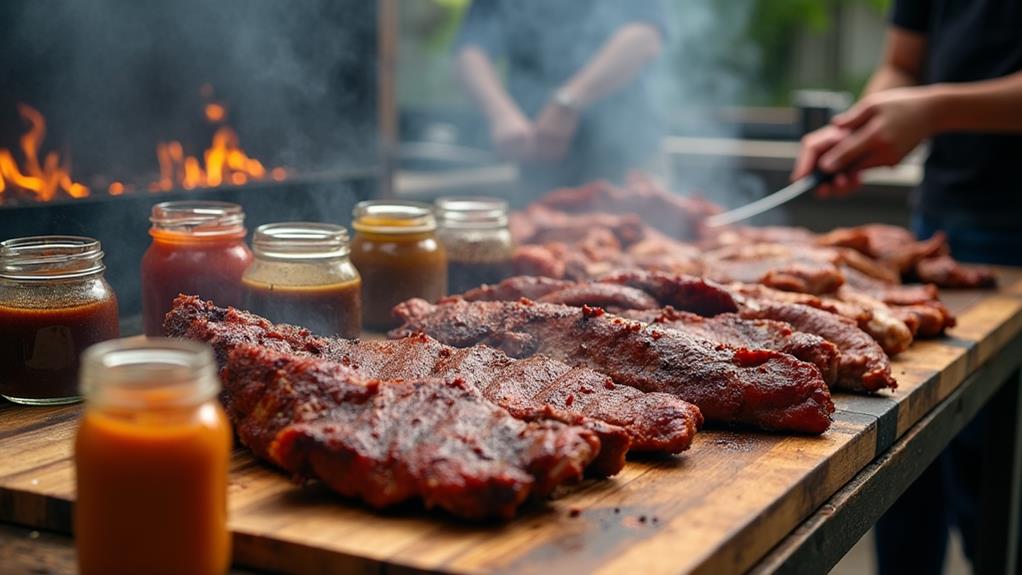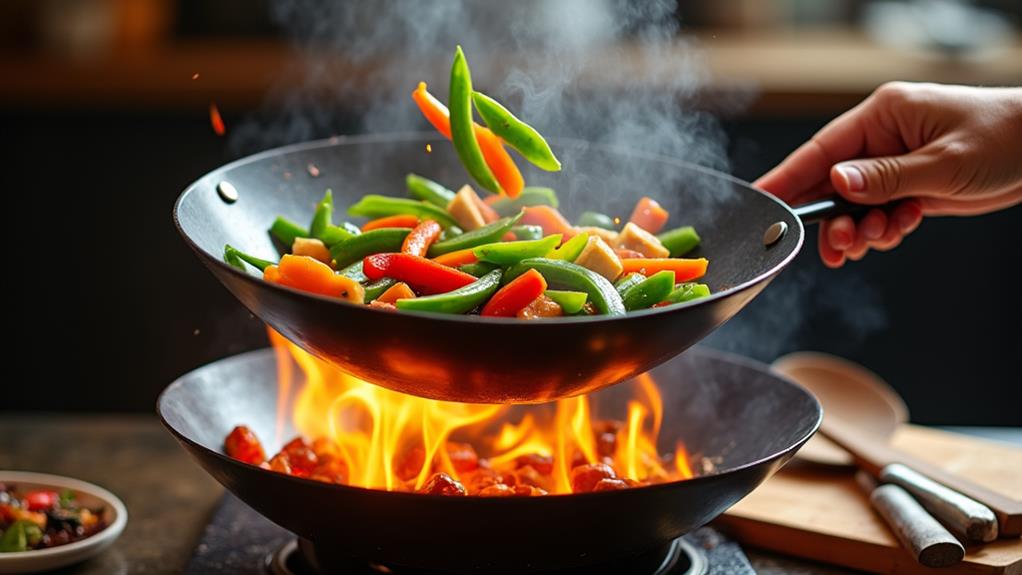Master oil-free veggie sautéing to create flavorful, nutrient-rich dishes without added fats. Start by investing in quality non-stick cookware and preheating your pan properly. Select seasonal vegetables, cut them uniformly, and add them in order of density. Control heat carefully, starting high to remove moisture, then reducing to medium for even cooking. Enhance flavor with aromatic liquids, herbs, and spices, adding them at strategic times during the cooking process. Finish your dish with fresh garnishes, crunchy toppings, or zesty sauces for added texture and taste. By honing these techniques, you'll unlock a world of healthy, delicious possibilities in your kitchen.
Why Choose Oil-Free Sautéing
Despite popular belief, sautéing vegetables without oil isn't only possible but also offers numerous health benefits. When you choose oil-free sautéing, you're embracing a cooking method that aligns with modern health-conscious lifestyles. By eliminating added fats, you'll significantly reduce calorie intake and minimize the risk of heart disease associated with excessive oil consumption.
Utilizing fresh ingredients like seasonal vegetables, as seen in Harvest Vegetable Soup, can further enhance the nutritional profile of your meals. This method highlights the natural flavors of vegetables, encouraging their unique textures and tastes to shine through.
Beyond personal health, oil-free sautéing has a positive environmental impact. You'll reduce your carbon footprint by avoiding the production and transportation of cooking oils. This eco-friendly approach extends to your kitchen, too, as you'll have less greasy residue to clean up.
For the budget-conscious cook, oil-free sautéing presents cost-effective options. You'll save money on expensive oils while still creating delicious meals. This technique also encourages culinary creativity, challenging you to explore new flavors and textures.
You'll discover innovative ways to enhance your dishes using herbs, spices, and natural vegetable juices.
Essential Equipment for No-Oil Cooking
To successfully sauté vegetables without oil, you'll need the right equipment in your kitchen. Non-stick cookware options, such as ceramic or well-seasoned cast iron pans, are essential for preventing food from sticking and burning.
Additionally, you may want to explore steam sauté accessories, like perforated silicone mats or specialized steamers, which can help you achieve that perfect tender-crisp texture in your oil-free veggie dishes.
Non-Stick Cookware Options
Investing in quality non-stick cookware is crucial for successful oil-free cooking. When choosing your equipment, you'll want to consider two popular options: ceramic cookware and cast iron pans.
Ceramic cookware offers a smooth, non-reactive surface that's perfect for low-fat cooking techniques. It's lightweight, easy to clean, and distributes heat evenly, making it ideal for sautéing vegetables without oil.
Cast iron, on the other hand, provides a naturally non-stick surface when properly seasoned. While it may require more maintenance, it's incredibly durable and can last for generations. Cast iron pans retain heat exceptionally well, allowing you to achieve a perfect sear on your vegetables without the need for added oils.
For those seeking cutting-edge solutions, look into newer materials like titanium-infused ceramic or diamond-coated pans. These innovative options offer superior non-stick properties and durability.
Regardless of your choice, ensure your cookware is free from harmful chemicals like PFOA and PTFE. By selecting the right non-stick cookware, you'll be well-equipped to create delicious, oil-free veggie sautés that are both healthy and flavorful.
Steam Sauté Accessories
Equipping your kitchen with the right steam sauté accessories is essential for successful oil-free cooking. To elevate your culinary game, invest in high-quality steam baskets that fit seamlessly into your existing pots and pans. These versatile tools allow you to steam-sauté vegetables while retaining their nutrients and flavors.
Look for stackable options to maximize efficiency and cook multiple ingredients simultaneously.
Next, consider specialized sauté tools designed for oil-free cooking. Silicone-tipped tongs and spatulas are ideal for handling delicate vegetables without scratching your non-stick cookware. A heat-resistant splatter screen helps contain moisture during the steam-sauté process, ensuring even cooking and preventing burns.
Don't overlook the importance of a reliable kitchen thermometer to monitor your pan's temperature accurately. This precision allows you to maintain the perfect heat for steam-sautéing without burning your vegetables.
Selecting and Prepping Vegetables

When it comes to creating a delicious oil-free veggie sauté, choosing the right vegetables is crucial. Start by focusing on seasonal vegetable selection, which ensures you're working with the freshest, most flavorful produce available.
You'll find that in-season veggies not only taste better but also offer superior nutritional value.
Once you've selected your vegetables, it's time to prep them properly. Begin with thorough washing techniques to remove any dirt or potential contaminants. For leafy greens, a quick soak in cold water followed by a gentle rinse works wonders.
For firmer vegetables like carrots or bell peppers, scrub them under running water with a vegetable brush.
After washing, cut your vegetables into uniform sizes to ensure even cooking. Consider the texture and cooking time of each vegetable when deciding on the order to add them to your sauté.
Denser vegetables like carrots or broccoli stems should go in first, while more delicate items like spinach or mushrooms can be added towards the end.
Mastering Heat and Timing
To master the art of oil-free veggie sautéing, you'll need to focus on heat and timing.
Start by preheating your pan properly, ensuring it's hot enough to sear vegetables without burning them.
As you cook, control the temperature carefully to achieve the perfect balance of crispness and tenderness, adjusting the heat as needed for different vegetables.
Preheating the Pan Properly
Preheating your pan correctly is crucial for achieving a perfect oil-free veggie sauté. The pan temperature and preheat duration play vital roles in ensuring your vegetables cook evenly and develop a delicious caramelized exterior without sticking or burning.
To start, place your dry pan on the stovetop over medium heat and allow it to warm up for about 3-5 minutes. You'll know it's ready when you can feel the heat radiating from the surface by holding your hand a few inches above it.
For optimal results, use a heavy-bottomed pan, such as cast iron or stainless steel, which distributes heat more evenly. Avoid non-stick pans, as they may release harmful chemicals when heated to high temperatures.
Once preheated, test the pan's readiness by sprinkling a few drops of water onto its surface. If the water droplets sizzle and dance across the pan, you've reached the ideal temperature for sautéing. If the water immediately evaporates, your pan is too hot; reduce the heat slightly and wait a minute before testing again.
With proper preheating, you'll set the stage for a successful oil-free veggie sauté.
Controlling Temperature for Crispness
Mastering temperature control is essential for achieving the perfect crispness in your oil-free veggie sauté. To maintain the ideal heat level, you'll need to adjust your burner settings throughout the cooking process.
Start with medium-high heat to quickly evaporate any moisture on the vegetables' surface, then reduce to medium as you continue cooking. This technique ensures a crisp texture without burning.
Pay close attention to your vegetables' behavior in the pan. They should sizzle gently but not smoke or char. If you notice excessive browning, lower the heat immediately. Conversely, if there's too much moisture accumulating, increase the temperature slightly to promote evaporation.
For optimal results, follow these temperature control tips:
- Use a heavy-bottomed pan for even heat distribution
- Avoid overcrowding the pan, which can lead to steaming instead of sautéing
- Stir frequently to prevent hot spots and ensure uniform cooking
Timing Each Vegetable's Addition
With temperature control mastered, it's time to focus on the art of adding vegetables to your oil-free sauté. Timing is crucial to achieve the perfect texture and flavor for each component.
Start by considering vegetable compatibility and cooking order to create a harmonious dish. The method of cooking each vegetable separately, similar to the traditional preparation of Ratatouille's technique, can influence their final texture and taste.
Begin with aromatics like onions and garlic, which form the flavor base. These need time to release their essences and caramelize slightly.
Next, add harder vegetables such as carrots, celery, and bell peppers. Their longer cooking time allows them to soften while maintaining a pleasant crunch.
As you progress, introduce softer vegetables like zucchini and mushrooms. These require less time and will quickly absorb the flavors of the aromatics.
Flavorful Liquids for Sautéing

Instead of oil, flavorful liquids can elevate your oil-free veggie sautés to new heights. By choosing the right liquid, you'll infuse your vegetables with delicious tastes while keeping them moist and tender. Aromatic broth, vegetable stock, and wine reductions are excellent options for creating a savory base, echoing traditional cooking methods seen in dishes like savory bread pudding that rely on rich flavors.
For a tangy twist, try citrus juice or balsamic vinegar. These acidic liquids not only add flavor but also help break down tougher vegetables.
Experiment with these innovative liquid combinations to revolutionize your oil-free sautés:
- Coconut aminos and apple cider for a sweet-and-sour profile
- Miso paste diluted in water for an umami-rich experience
- Tahini sauce thinned with lemon juice for a creamy, Middle Eastern flair
Don't be afraid to mix and match these liquids to create your own signature blends. Start with small amounts and adjust to taste.
Herbs and Spices for Depth
Herbs and spices play a starring role in creating depth and complexity in oil-free veggie sautés. They're your secret weapons for transforming simple vegetables into exciting, flavorful dishes.
Start by experimenting with classic herb combinations like rosemary and thyme, or basil and oregano. These pairings can elevate your sauté, adding layers of flavor that'll make your taste buds sing.
Don't shy away from spice blends, either. Indian-inspired garam masala or Middle Eastern za'atar can transport your vegetables to new culinary heights. For a smoky kick, try smoked paprika or chipotle powder.
When using dried herbs and spices, add them early in the cooking process to allow their flavors to fully develop. Fresh herbs, on the other hand, are best added towards the end to preserve their delicate aromas.
Finishing Touches for Vibrant Dishes

The perfect oil-free veggie sauté comes together with carefully chosen finishing touches. These final elements elevate your dish from good to exceptional, adding bursts of flavor, texture, and visual appeal.
To create vibrant, innovative dishes, consider these garnishing techniques and finishing sauces:
- Fresh herbs: Sprinkle chopped cilantro, basil, or parsley over your sauté for a pop of color and fresh flavor.
- Crunchy toppings: Add toasted nuts, seeds, or crispy chickpeas for a satisfying textural contrast.
- Zesty sauces: Drizzle a tangy tahini dressing, spicy sriracha, or creamy cashew sauce to enhance the overall taste profile.
When applying these finishing touches, remember that less is often more. Use them sparingly to complement, not overpower, your carefully prepared vegetables.
For a professional presentation, consider using a squeeze bottle for precise sauce application or tweezers for delicate herb placement.
Don't forget the power of acid; a splash of lemon juice or a few drops of high-quality vinegar can brighten the entire dish.
With these techniques, you'll transform your oil-free veggie sauté into a restaurant-worthy creation that delights both the eyes and the palate.
Flavor-Boosting Ingredients and Techniques
While a well-executed oil-free veggie sauté can be delicious on its own, incorporating flavor-boosting ingredients and techniques can elevate your dish to new heights.
Begin by infusing aromatics like garlic, ginger, or shallots into your cooking liquid, creating a fragrant base for your vegetables. Next, layer flavors by adding umami boosters such as nutritional yeast, miso paste, or mushroom powder, which provide depth and complexity to your sauté.
To enhance acidity and brighten the dish, consider incorporating citrus zest, vinegar, or a splash of white wine. These ingredients not only add tang but also help to balance the overall flavor profile.
Don't forget about seasoning techniques: use herbs and spices strategically, adding some at the beginning for a mellow flavor and others at the end for a fresh punch.
For texture contrast, try incorporating nuts, seeds, or crispy vegetables like water chestnuts. This adds an interesting mouthfeel to your sauté.
Frequently Asked Questions
Can Oil-Free Sautéing Be Used for All Types of Cuisines?
You can adapt oil-free sautéing to various cuisines. It's a versatile technique that enhances flavors across culinary traditions. Experiment with different spices, herbs, and cooking liquids to recreate traditional dishes or invent innovative flavor combinations in your oil-free creations.
How Does Oil-Free Sautéing Affect the Calorie Content of Dishes?
Did you know oil-free sautéing can cut calories by up to 80%? You'll experience significant calorie reduction without sacrificing flavor. It's a game-changer for health-conscious foodies, enhancing taste while revolutionizing your cooking approach. Embrace this innovative technique for guilt-free indulgence.
Are There Any Vegetables That Don't Work Well With Oil-Free Sautéing?
You'll find most veggies adapt well to oil-free sautéing, but dense root vegetables might struggle. They can be tougher and less flavorful due to texture differences and reduced moisture retention. Experiment with pre-steaming or longer cooking times for these stubborn varieties.
Can Oil-Free Sautéed Vegetables Be Frozen for Later Use?
Curious about preserving your oil-free sautéed veggies? You can freeze them! While some texture changes may occur, proper freezing methods can maintain their quality. Try flash-freezing or vacuum-sealing for innovative ways to keep your healthy creations on hand.
How Does Oil-Free Sautéing Impact the Nutritional Value of Vegetables?
You'll boost nutrient retention with oil-free sautéing, preserving more vitamins and minerals. It's a game-changer for flavor enhancement too, intensifying natural tastes. You're unlocking the full potential of your veggies with this innovative cooking method.
Final Thoughts
You've now unlocked the secrets to creating incredibly flavorful, oil-free veggie sautés that'll make your taste buds dance with joy! With these techniques, you'll transform simple vegetables into culinary masterpieces that'll rival any restaurant dish. Remember, patience is key when mastering heat control, and don't be afraid to experiment with different herb and spice combinations. Your newfound skills will revolutionize your cooking, making healthy eating not just a choice, but an exciting, delicious adventure. Embrace the world of oil-free sautéing and savor every bite!















